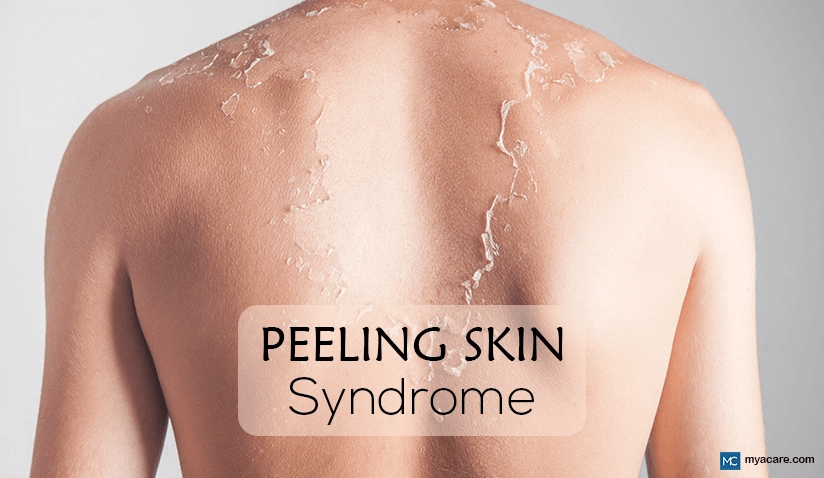Peeling Skin Syndrome: Causes, Symptoms, and Management

Medically Reviewed and Updated by Dr. Rosmy Barrios - August 21, 2024
Definition and Types of Peeling Skin Syndrome
Causes and Inheritance Patterns
Peeling skin syndrome (PSS) is a rare genetic ailment that affects the skin's ability to renew itself, resulting in excessive skin peeling. This disorder can profoundly impact the affected person’s physical and emotional well-being.
This blog uncovers the causes, symptoms, and management of peeling skin syndrome, as well as the latest research advancements and potential treatments.
Definition and Types of Peeling Skin Syndrome
Peeling skin syndrome refers to a group of rare genetic disorders that cause the skin to peel excessively. This condition exhibits skin weakness and frequent shedding of the top layer of the skin (epidermis) in large sheets or flakes. It belongs to a broader group of genetic skin peeling disorders known as congenital ichthyosis (skin peeling).[1]
There are three main types of peeling skin syndrome: generalized peeling skin syndrome (GPSS), type A and type B and localized peeling skin syndrome (LPSS), type C. Each type has its unique characteristics and symptoms.
Peeling skin syndrome is an inherited disorder that affects both males and females. Over 100 reported cases of this disorder have occurred in different population groups.[2] Depending on the type, 1 in every 1000 to 10 million people is born with the disorder. For example, the prevalence for Peeling skin syndrome type A (a noninflammatory form of generalized PSS characterized by white scaling and superficial painless peeling of the skin), the prevalence is <1 / 1 000 000.[3]
Symptoms and Variations
The main symptom of peeling skin syndrome is excessive skin peeling with lifelong recurrence. In this condition, the skin peels off in larger patches. The skin is weaker than usual and peels off more when exposed to water. Other symptoms may include redness, itching, and pain.
The severity and pattern of peeling can vary depending on the type and subtype of PSS. Most people with the condition experience symptoms from birth or before six years of age.
Generalized PSS Symptoms: Type A and B are known as generalized type, as the symptoms are found all over the body. Those with PSS type A display asymptomatic painless skin peeling without signs of inflammation. Type B patients display redness, itching, and pain when their skin peels.
Localized PSS Symptoms: Individuals with type C experience blistering and peeling skin on the soles of the feet and palms of the hands.
Impact on Psychological and Emotional Well-being
Peeling skin syndrome can significantly impact an individual's psychological and emotional well-being. The constant shedding of skin can be embarrassing and may lead to feelings of self-consciousness and low self-esteem. It can also be physically uncomfortable and painful, affecting an individual's overall well-being.
Causes and Inheritance Patterns
Peeling skin syndrome is caused by genetic mutations affecting the skin's ability to renew.
These genes play crucial roles in skin cell adhesion and shedding. The specific gene involved determines the type of PSS:
- Generalized non-inflammatory PSS: FLG2, CAST, SERPINB8, or CHST8 genes
- Generalized inflammatory PSS: CDSN, DSG1, or SPINK5 genes
- Localized PSS: TGM5 or CSTA genes
These mutations disrupt the normal process of skin cell shedding, leading to the excessive peeling characteristic of PSS.
The skin disorder has an autosomal recessive inheritance pattern, meaning both parents must pass down a copy of the defective gene(s) for a child to be affected. A child with one copy becomes a carrier of the disease.[4]
Risk Factors
The main risk factor for PSS is having a family history of the condition.
Certain environmental factors can also trigger or worsen symptoms, such as:
- Exposure to sunlight
- High environmental temperatures
- Skin abrasion
- Water exposure
PSS may pertain to other medical conditions, such as allergies or metabolic diseases.
Diagnosis and Recognition
Diagnosing peeling skin syndrome can be challenging, as it is rare and can be mistaken for other skin disorders. The condition often improves with age and is commonly misdiagnosed or overlooked throughout the patient's lifespan.
A proper diagnosis requires a thorough physical examination, family history, and genetic testing. Healthcare professionals often refer patients to a genetic counselor for further testing and support.
Genetic Counseling and Support Networks
Genetic counseling is essential to managing peeling skin syndrome. A genetic counselor helps those affected and their families to comprehend inheritance patterns, potential risks, and available treatment options. They can also offer emotional support and unite their clients with support networks and resources.
Management and Therapies
Currently, this condition has no cure. Present recommendations can help alleviate symptoms and improve an individual's quality of life.
Medications
Topical medications that can help manage symptoms include emollients and keratolytics. Keratolytics assist with quicker exfoliation, allowing for a better overall appearance. Emollients can help to keep the skin moist and reduce excess shedding. These topical preparations may offer the most benefit when used together throughout the patient's skincare routine.
An oral retinoid prescription may reduce skin peeling and inflammation in severe cases.
Self-care Strategies
Self-care strategies can better manage symptoms and prevent skin peeling. These involve avoiding triggers and maintaining a consistent skincare routine. It is essential to moisturize the skin regularly and protect it from environmental factors that may trigger symptoms.
A skin specialist will likely recommend applying moisturizer after wetting the skin and using sunblock when in the sun. Soft, breathable clothing can minimize skin friction.
Potential Treatments and Future Outlook
Research advancements in genetics and dermatology have led to potential treatments for peeling skin syndrome. One promising treatment is gene therapy, which involves substituting a mutated gene with a functional copy to correct the underlying cause of PSS. However, more research is needed before this type of treatment can be widely available.
Recent breakthroughs encompass liposomal gene therapy aimed at restoring CDSN for those with PSS type B (generalized inflammatory PSS)[5] and gene therapy to restore the TGM5 gene in type C (localized PSS)[6].
The development of these therapies is still in its infancy and has not yet made it to clinical trials.
Conclusion
Peeling skin syndrome is a rare genetic skin condition that can potentially leave a great impact on an individual's physical and emotional well-being. Healthcare professionals need to refer patients to a genetic counselor for proper diagnosis and management. With the latest research advancements and potential treatments, there is hope for individuals living with PSS to improve their quality of life.
To search for the best health providers for dermatology in Croatia, Germany, Greece, Italy, Malaysia, Singapore, Slovakia Spain, Thailand, The UAE, the UK, and the US, please use our free search engine.
The Mya Care Editorial Team comprises medical doctors and qualified professionals with a background in healthcare, dedicated to delivering trustworthy, evidence-based health content.
Our team draws on authoritative sources, including systematic reviews published in top-tier medical journals, the latest academic and professional books by renowned experts, and official guidelines from authoritative global health organizations. This rigorous process ensures every article reflects current medical standards and is regularly updated to include the latest healthcare insights.

Dr. Rosmy Barrios is an aesthetic medicine specialist with international work experience. She earned her physician diploma at the Universidad Del Norte’s School of Medicine in Barranquilla, Colombia, and her specialty at John F. Kennedy University in Buenos Aires, Argentina. Dr. Barrios is a member of the Pan-American Aesthetic Medicine Association (PASAM) and the Union Internationale de Médecine Esthétique (UIME). She is an expert health writer with keen interests in aesthetic medicine, regenerative aesthetics, anti-aging, fitness, and nutrition. Currently, Dr. Barrios heads the Regenerative Aesthetics department at a renowned Internal Medicine clinic based in Belgrade, Serbia.
Sources:
Featured Blogs



